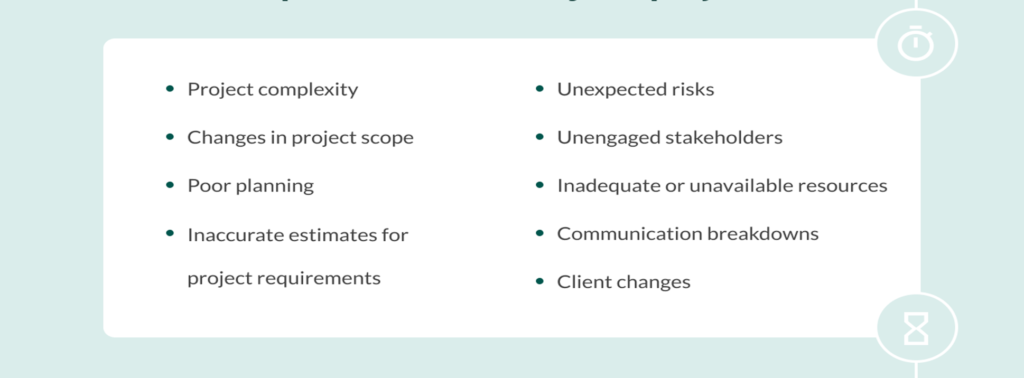Project Delays
When projects are time overrun (i.e., delayed), cost overrun will be the result. Cost overrun happen when the projects consumer more resources than what is estimated.
It is natural when the projects are delayed, more resources, in terms of material, money, manpower, will be required and thus, the cost overruns happen.
The project delays happen when they take more time than what is estimated and it is called as time overrun.


Causes of delay:
External Causes of Delay
Internal Causes of delay

External Causes of Delay:
There are several reasons, including socio-political, economic, technological, macro and micro-global reasons, for the delay of several projects according to the response of several project managers. Professional project managers need to identify the real reasons in order to prevent such delays in future. Some illustrative, not exhaustive, causes of delay are given below, categorized external and internal.
The external factors include uncontrollable factors, such as:
Government policies
Import regulations
Panic taxation
Resource constraints
Defense expenditure
Political situation
Inflation

Internal Causes of delay:



Nine common reason for project delay:

Project complexity:
Complexity is one of the major factors for a time delay and cost overrun. Complex projects usually have a long implementation duration in comparison to the small ones. It may result in changes in price, exchange rates, and inflation rates.
Increased costs and long chains of negotiation eventually cause a delay in the overall project duration. Moreover, tasks with a high degree of complexity usually require complex plans, schedules, and estimations.

Changes in project scope:
The scope defines the deliverables that are expected at the end of every project. Different changes in project scope or its poor definition can also produce severe delays.
These changes can happen due to project funding issues, miscalculations of inherent risks and uncertainties, changes in the clients’ interests, and so on. It can lead to changed deliverables, budget, or the entire team.

Poor planning:
Poor planning and scheduling can also affect delays. It includes identifying the tasks or work activities to obtain the desired outcome in minimum time and costs. So any team must understand how to create a plan before executing activities to confirm the workflow, the value of money, and timely tasks completion.

Inaccurate estimates for project requirements:
When it comes to requirements, inaccuracies can happen quite often.
The lack of documented requirements prevents the achievement of project goals. Remember that even a single improper requirement has the potential to affect all project processes.

Unexpected risk:
There are no projects without risks. Managers know it and strive to identify all these potential risks in advance.
Unexpected risks can arise due to less involvement of the project manager. They can relate to running out of technical staff, new stakeholders demands, or the unavailability of reliable tools to handle problems. These kinds of risks can cause significant damage to the entire business.

Unengaged stakeholder:
Another cause for the projects being behind schedule is less involvement and a communication gap between team members and stakeholders.
Often, essential documents are not communicated to stakeholders on time. It deprives them of the right to review the activities of the project. It commonly happens in the IT industry and results in delays.

Inadequate or unavailable resource:
Inadequate or unavailable resources (both human and material) are also a significant cause of a project delay.
Your project can quickly get behind if team members get sick, quit, or switch to another project. When software breaks down, your budget can also promptly get cut. That is why managers should always know how to allocate resources in order to prevent significant delays.

Communication breakdowns:
Both internal and external communication needs to flow with ease.
The completion of your project can also involve many departments and stakeholders. Communication breakdowns or even the lack of communication can cause setbacks in processing and hold up execution, resulting in delays in project completion.
Client changes:
Late clients’ requests can throw the timing off track. When a client decides to alter the scope of a project by making any additions or deletions, the entire timeline will have to be reworked. That is why it is vital to require clients to sign off on a detailed contractual description of the project before its start.
How to overcome project delay
•Plan Correctly
•Keep All Deadline Realistic
•Collect Accurate Data
•Invite the right People to Plan Process
•Conduct Frequent Team Meetings
•Ensure Reliable Project Control
•Measure Progress
•Define Task Dependencies
•Seek the Opportunity for Improvement
•Find th Positive Associated with Delays
Benefits of project management
1. Clear, organized plans improve team collaboration:
To successfully manage a project, you need to prioritize. You’ll never have as much time and resources as we’d all hope for, so to do it all you need to focus on the items that will have the most impact. Then make sure these priorities are clear to stakeholders so you can set expectations and to your team so they focus on the right work.”
2. Defining everyone’s role eliminates confusion:
Once the prep work is done, it’s on to the actual management part of project management. However, without a clear project owner to help your team across the finish line, it’s all too easy for teammates to drop tasks, forget details, or not know who to go to with questions.
3. Well-defined goals improve team effectiveness:
Projects aren’t successful when teams don’t know what their project goals are. Without clear goals, teams not only lack intrinsic motivation—they also run the risk of working towards the wrong objective or toiling away at low-impact work.
4. Defining a communication plan keeps your team aligned and focused:
The term may be project “management,” but managing a project is only one piece of the puzzle. Before you even get started on work, you should align on a communication plan. Your team likely has an email management tool, an instant messaging tool, and a project management tool, among others.
5. Project management tools help increase efficiency:
To put these tips into action, consider using a project management tool to help your team better collaborate and stay on track.
While there are literally dozens of tools you could choose from, you’ll want to avoid looking at more traditional project management tools since most of these tools are built for more traditional processes and can take a lot of time to set up and onboard.
